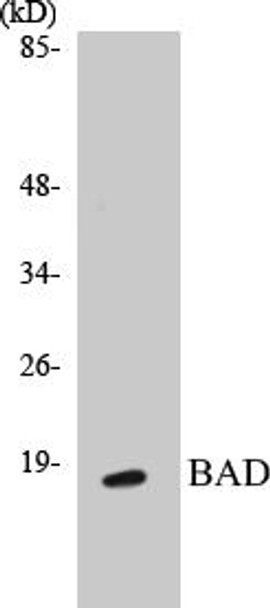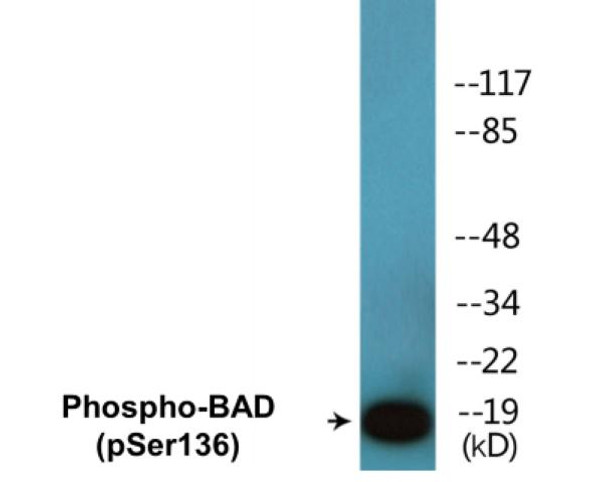Description
BAD Colorimetric Cell-Based ELISA Kit
The Bad Colorimetric Cell-Based ELISA Kit is a cutting-edge product designed for the precise measurement of angiogenin levels in various samples, including human serum, plasma, and cell culture supernatants. With its unparalleled sensitivity and specificity, this kit delivers accurate and consistent results, making it an invaluable tool for research in a variety of fields.Angiogenin is a key player in angiogenesis, the process of forming new blood vessels, and its levels can provide crucial insights into conditions such as cancer, cardiovascular diseases, and neurodegenerative disorders.
By utilizing the Bad Colorimetric Cell-Based ELISA Kit, researchers can effectively study the role of angiogenin in these diseases and explore potential therapeutic interventions. Trust in the precision and reliability of this kit to advance your research efforts and drive new discoveries in the field.
| Product Name: | BAD Colorimetric Cell-Based ELISA Kit |
| Product Code: | CBCAB00541 |
| ELISA Type: | Cell-Based |
| Target: | BAD |
| Reactivity: | Human, Mouse, Rat |
| Dynamic Range: | > 5000 Cells |
| Detection Method: | Colorimetric 450 nmStorage/Stability:4°C/6 Months |
| Format: | 96-Well Microplate |
The BAD Colorimetric Cell-Based ELISA Kit is a convenient, lysate-free, high throughput and sensitive assay kit that can detect BAD protein expression profile in cells. The kit can be used for measuring the relative amounts of BAD in cultured cells as well as screening for the effects that various treatments, inhibitors (ie siRNA or chemicals), or activators have on BAD.
Qualitative determination of BAD concentration is achieved by an indirect ELISA format. In essence, BAD is captured by BAD-specific primary antibodies while the HRP-conjugated secondary antibodies bind the Fc region of the primary antibody. Through this binding, the HRP enzyme conjugated to the secondary antibody can catalyze a colorimetric reaction upon substrate addition. Due to the qualitative nature of the Cell-Based ELISA, multiple normalization methods are needed:
| 1. | A monoclonal antibody specific for human GAPDH is included to serve as an internal positive control in normalizing the target absorbance values. |
| 2. | Following the colorimetric measurement of HRP activity via substrate addition, the Crystal Violet whole-cell staining method may be used to determine cell density. After staining, the results can be analysed by normalizing the absorbance values to cell amounts, by which the plating difference can be adjusted. |
| Database Information: | Gene ID: 572, UniProt ID: Q92934, OMIM: 603167, Unigene: Hs.370254 |
| Gene Symbol: | BAD |
| Sub Type: | None |
| UniProt Protein Function: | BAD: a proapoptotic member of the Bcl-2 family. Displaces Bax from binding to Bcl-2 and Bcl-xL, resulting in cell death. Survival factors such as IL-3 can inhibit the apoptotic activity of Bad inducing the phosphorylation of Bad by Akt and p90RSK. 14-3-3 proteins bind phosphorylated Bad, inhibiting its binding to Bcl-2 and Bcl-xL. Phosphorylation by mitochondria-anchored PKA in the BH3 domain can block the dimerization of Bad and Bcl-xL. |
| UniProt Protein Details: | Protein type:Apoptosis Chromosomal Location of Human Ortholog: 11q13.1 Cellular Component: mitochondrial outer membrane; mitochondrion; cytosol Molecular Function:protein kinase B binding; protein binding; protein heterodimerization activity; phospholipid binding; caspase activator activity; lipid binding; protein kinase binding; protein phosphatase 2B binding Biological Process: response to oleate; nerve growth factor receptor signaling pathway; positive regulation of apoptosis; positive regulation of proteolysis; apoptosis; response to glucocorticoid stimulus; positive regulation of caspase activity; glucose homeostasis; cellular process regulating host cell cycle in response to virus; response to estradiol stimulus; positive regulation of apoptosis by virus; response to glucose stimulus; pore complex biogenesis; positive regulation of autophagy; positive regulation of glucokinase activity; caspase activation; response to drug; epidermal growth factor receptor signaling pathway; release of cytochrome c from mitochondria; fibroblast growth factor receptor signaling pathway; phosphoinositide-mediated signaling; cytokine and chemokine mediated signaling pathway; suppression by virus of host apoptosis; ADP metabolic process; positive regulation of insulin secretion; response to testosterone stimulus; response to amino acid stimulus; ATP metabolic process; glucose catabolic process; response to ethanol; positive regulation of T cell differentiation; induction of apoptosis via death domain receptors; DNA damage response, signal transduction resulting in induction of apoptosis; response to hydrogen peroxide; innate immune response; positive regulation of B cell differentiation; regulation of mitochondrial membrane permeability; response to progesterone stimulus; response to calcium ion; positive regulation of epithelial cell proliferation |
| NCBI Summary: | The protein encoded by this gene is a member of the BCL-2 family. BCL-2 family members are known to be regulators of programmed cell death. This protein positively regulates cell apoptosis by forming heterodimers with BCL-xL and BCL-2, and reversing their death repressor activity. Proapoptotic activity of this protein is regulated through its phosphorylation. Protein kinases AKT and MAP kinase, as well as protein phosphatase calcineurin were found to be involved in the regulation of this protein. Alternative splicing of this gene results in two transcript variants which encode the same isoform. [provided by RefSeq, Jul 2008] |
| UniProt Code: | Q92934 |
| NCBI GenInfo Identifier: | 17371773 |
| NCBI Gene ID: | 572 |
| NCBI Accession: | Q92934.3 |
| UniProt Secondary Accession: | Q92934,O14803, Q6FH21, |
| UniProt Related Accession: | Q92934 |
| Molecular Weight: | 168 |
| NCBI Full Name: | Bcl2-associated agonist of cell death |
| NCBI Synonym Full Names: | BCL2-associated agonist of cell death |
| NCBI Official Symbol: | BAD |
| NCBI Official Synonym Symbols: | BBC2; BCL2L8 |
| NCBI Protein Information: | bcl2-associated agonist of cell death; bcl2-L-8; BCL2-binding protein; bcl-2-like protein 8; BCL2-binding component 6; bcl-2-binding component 6; BCL-X/BCL-2 binding protein; bcl2 antagonist of cell death; BCL2-antagonist of cell death protein; bcl-XL/Bcl-2-associated death promoter |
| UniProt Protein Name: | Bcl2-associated agonist of cell death |
| UniProt Synonym Protein Names: | Bcl-2-binding component 6; Bcl-2-like protein 8; Bcl2-L-8; Bcl-xL/Bcl-2-associated death promoter; Bcl2 antagonist of cell death |
| Protein Family: | Bcl2-associated agonist of cell death |
| UniProt Gene Name: | BAD |
| UniProt Entry Name: | BAD_HUMAN |
| Component | Quantity |
| 96-Well Cell Culture Clear-Bottom Microplate | 2 plates |
| 10X TBS | 24 mL |
| Quenching Buffer | 24 mL |
| Blocking Buffer | 50 mL |
| 15X Wash Buffer | 50 mL |
| Primary Antibody Diluent | 12 mL |
| 100x Anti-Phospho Target Antibody | 60 µL |
| 100x Anti-Target Antibody | 60 µL |
| Anti-GAPDH Antibody | 60 µL |
| HRP-Conjugated Anti-Rabbit IgG Antibody | 12 mL |
| HRP-Conjugated Anti-Mouse IgG Antibody | 12 mL |
| SDS Solution | 12 mL |
| Stop Solution | 24 mL |
| Ready-to-Use Substrate | 12 mL |
| Crystal Violet Solution | 12 mL |
| Adhesive Plate Seals | 2 seals |
The following materials and/or equipment are NOT provided in this kit but are necessary to successfully conduct the experiment:
- Microplate reader able to measure absorbance at 450 nm and/or 595 nm for Crystal Violet Cell Staining (Optional)
- Micropipettes with capability of measuring volumes ranging from 1 µL to 1 ml
- 37% formaldehyde (Sigma Cat# F-8775) or formaldehyde from other sources
- Squirt bottle, manifold dispenser, multichannel pipette reservoir or automated microplate washer
- Graph paper or computer software capable of generating or displaying logarithmic functions
- Absorbent papers or vacuum aspirator
- Test tubes or microfuge tubes capable of storing ≥1 ml
- Poly-L-Lysine (Sigma Cat# P4832 for suspension cells)
- Orbital shaker (optional)
- Deionized or sterile water
*Note: Protocols are specific to each batch/lot. For the correct instructions please follow the protocol included in your kit.
| Step | Procedure |
| 1. | Seed 200 µL of 20,000 adherent cells in culture medium in each well of a 96-well plate. The plates included in the kit are sterile and treated for cell culture. For suspension cells and loosely attached cells, coat the plates with 100 µL of 10 µg/ml Poly-L-Lysine (not included) to each well of a 96-well plate for 30 minutes at 37°C prior to adding cells. |
| 2. | Incubate the cells for overnight at 37°C, 5% CO2. |
| 3. | Treat the cells as desired. |
| 4. | Remove the cell culture medium and rinse with 200 µL of 1x TBS, twice. |
| 5. | Fix the cells by incubating with 100 µL of Fixing Solution for 20 minutes at room temperature. The 4% formaldehyde is used for adherent cells and 8% formaldehyde is used for suspension cells and loosely attached cells. |
| 6. | Remove the Fixing Solution and wash the plate 3 times with 200 µL 1x Wash Buffer for five minutes each time with gentle shaking on the orbital shaker. The plate can be stored at 4°C for a week. |
| 7. | Add 100 µL of Quenching Buffer and incubate for 20 minutes at room temperature. |
| 8. | Wash the plate 3 times with 1x Wash Buffer for 5 minutes each time. |
| 9. | Add 200 µL of Blocking Buffer and incubate for 1 hour at room temperature. |
| 10. | Wash 3 times with 200 µL of 1x Wash Buffer for 5 minutes each time. |
| 11. | Add 50 µL of 1x primary antibodies (Anti-BAD Antibody and/or Anti-GAPDH Antibody) to the corresponding wells, cover with Parafilm and incubate for 16 hours (overnight) at 4°C. If the target expression is known to be high, incubate for 2 hours at room temperature. |
| 12. | Wash 3 times with 200 µL of 1x Wash Buffer for 5 minutes each time. |
| 13. | Add 50 µL of 1x secondary antibodies (HRP-Conjugated AntiRabbit IgG Antibody or HRP-Conjugated Anti-Mouse IgG Antibody) to corresponding wells and incubate for 1.5 hours at room temperature. |
| 14. | Wash 3 times with 200 µL of 1x Wash Buffer for 5 minutes each time. |
| 15. | Add 50 µL of Ready-to-Use Substrate to each well and incubate for 30 minutes at room temperature in the dark. |
| 16. | Add 50 µL of Stop Solution to each well and read OD at 450 nm immediately using the microplate reader. |
(Additional Crystal Violet staining may be performed if desired – details of this may be found in the kit technical manual.)






